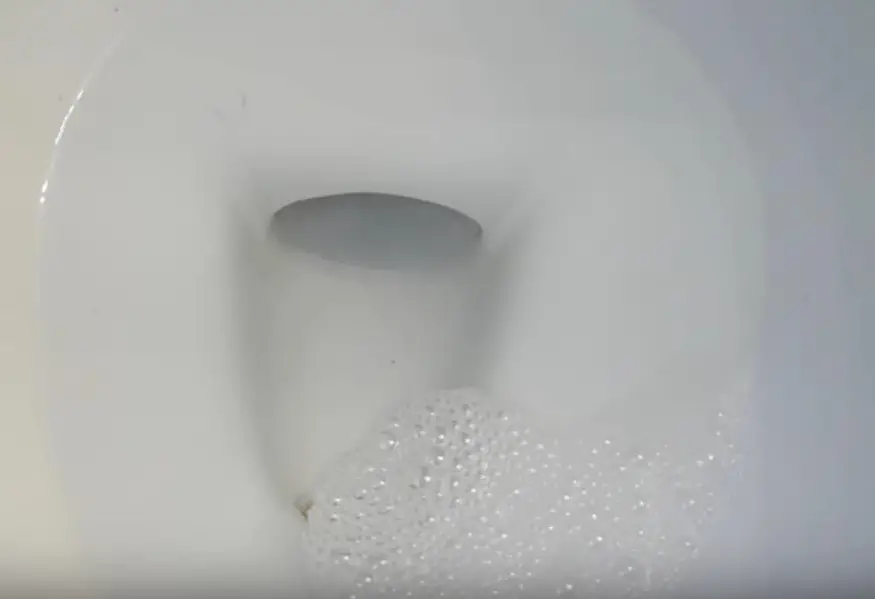Toilet Bubbles When Washer Drains? (We Have a Fix)

If you hear gurgles in your toilet, it means that air is escaping the pipes. If you hear water bubbling in your toilet while you finish your wash cycle, then that means your washing machine is pushing air through the tube.
The first thing you need to do if there is bubbling in your toilet when your washer is draining is to seal off all your drains, make sure there is no clog in your community’s sewage system, and then make sure there are no clogs in your own system.
Finally, to stop your toilet from bubbling, simply install a 2-inch drain with a P-trap. If this does not help, then you should go on to the roof and spray water into the main vent stack to clean it out.
The most common cause of bubbling in your toilet is due to blocked vents. Even if only one of your vents is blocked, this can create negative pressure, resulting in bubbling.
This occurs because water forms a seal around the pipes, which results in a vacuum. Because this vacuum is extremely strong, it will create a gurgling sound. Additionally, if this occurs, you may expose the bathroom to sewer gases resulting in bad odor.
One simple reason for why your toilet may be bubbling is because the main drain on the washing machine has a partial clog. This can easily cause it to bubble, because when the machine drains, the water path is restricted. This will force air and water to go back through the pipe, and bubble.
When this backflow occurs, sink drains may not be affected, but you will hear the gurgling in your toilet.
Another reason that will cause bubbling is that the fixture might be between the soil stack and the toilet. This can make the drain from the washer, connect to the drain of the toilet. Another option is that a fixture and the toilet can tie into the same stack. This is called “wet venting” and this can cause bubbling.
All bathrooms have vertical pipes that go to the roof in order to vent. One mistake that most contractors make when installing vent pipes, is that they do not have a cover. This can allow dirt and debris to fall into it. When this vent becomes clogged, it does not allow air to escape.
In order to allow the water in your home to drain properly, you need airflow. The same goes for sinks and tubs, but for toilet and washer vents you need a much higher amount of airflow.
When the pipe gets clogged, it will force the air out of the nearest opening. Often, this is a toilet drain, hence the bubbling.
If all of the other problems do not ring true to your situation, then you need to see if your washer drain works properly. The reason that the bubbling occurs in your toilet is that the washing machine releases air very quickly and under a lot of pressure.
If your washing machine drain is malfunctioning, it may be because it is not properly installed. The issue is that most people do not pay much attention when installing pipes. If this is not done by a plumber, then you may run into issues later down the road.
When installing washing machine pipes, not only do the pipes need to be the right size and diameter to function properly, but they also need to be set up properly. If not, the air will never reach the pipes, and then bubbling will occur in the toilet.
Your plumbing system consists of two small systems.
When water comes into your home it needs to go through a meter that measures how much water you have used. Next to this meter, you should also find an emergency valve. If you have a pipe break, it will flood your home.
Your drain system consists of various traps, vents, and cleanouts.
If any component fails, your entire drain system will be affected.
If the cause of the gurgling is within the drainpipe, then you may be able to fix the problem by plunging the toilet. This might allow you to fix a moderate clog. Since your bathtub, sink, and the shower is connected to the same drain, then you need to seal all of these drains off before plunging.
If you still have bubbling in your toilet, then you will need to go deeper remove the clogs.
Sometimes there is no clog in your personal drain, but rather a clog in a community sewer line. This can create bubbles in your toilet as well as your neighbors’ homes. If this is the case, you can call your municipal sewer authority and report the problem.
After attempting the other fixes, you will need to move on to investigating your vent stack. Because your drain system requires a large amount of air, your vents may be the culprit to your problem. To check the vent stack you will need to go on the roof. Be extremely careful if you plan to do this yourself.
If you cannot remove the clog, then you will need to call a professional.
In the case that you cannot remove clogs, you should call a plumber. You run the risk of breaking things in your drainage system if you do them improperly, so it is always good to bring in a professional.